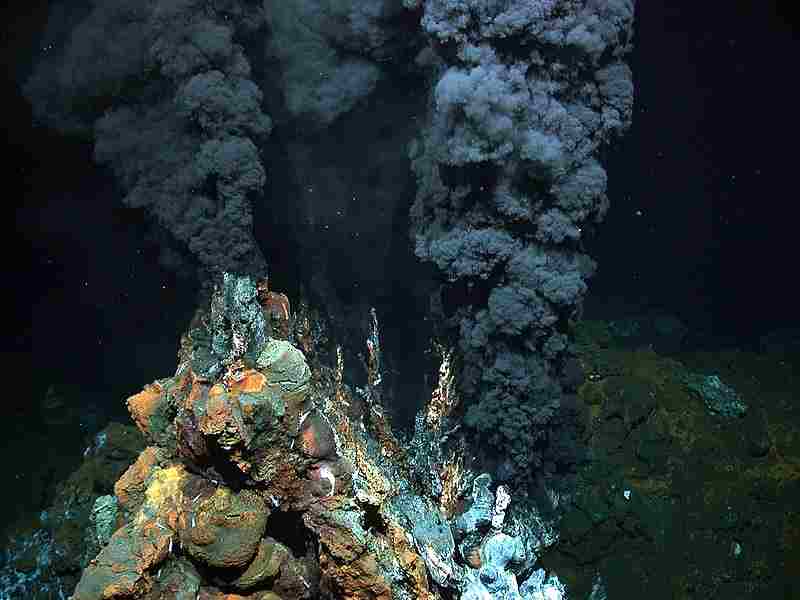9 Facts About the Abyssal Zone and Their Ecological Implications
Facts about the abyssal zone include its status as one of the Earth's largest ecoregions, its low light penetration, frigid temperatures, high concentration of nutrient salts, polar origin of water masses, low biodiversity, predominance of chemosynthesis for primary production, role of fecal pellets as a food source, and high specialization of organisms.
This article discusses some facts about the abyssal zone, as follows;
1). The Abyssal Zone is One of the Largest Ecoregions on Earth: One of the Facts About the Abyssal Zone
The abyssal zone, a region of the Earth's oceans, can be described as one of the most mysterious and enigmatic ecosystems on our planet.
Situated at extreme depths, typically lying between 2,000 and 6,000 meters (6,500 to 19,700 feet) below the ocean's surface, the abyssal zone is undoubtedly one of the largest ecoregions on Earth, covering an expansive portion of the world's seafloor. This statement unveils a fascinating fact about the abyssal zone, but it also carries profound ecological implications.
Ecological Implications of the Abyssal Zone's Size
Immense size can account for the unique biodiversity, ecosystem services, scientific exploration, and conservation challenges that are associated with the abyssal zone.
The abyssal zone spans a vast portion of the world's marine terrain, so that it is one of the largest ecoregions on the planet. Its size, coupled with its immense depth, creates a habitat for countless species.

In this seemingly inhospitable environment, life has adapted in distinctive ways to exploit the available resources. Creatures inhabiting the abyssal zone are often specially adapted to the extreme conditions, which include near-freezing temperatures, crushing pressure, and almost complete darkness.
Contrary to popular belief, the abyssal zone is not a barren oceanic wasteland. It houses a surprisingly diverse array of life, which range from bioluminescent fish to specialized invertebrates like giant tube worms and deep-sea corals. The extreme conditions of the abyssal zone have led to the evolution of species that are found nowhere else on Earth. This biodiversity is important to understanding the interconnectedness of life in terrestrial and aquatic ecosystems.
Ecological significance of the abyssal zone extends beyond its biodiversity. This ecoregion has a vital function in maintaining the overall vitality and stability of the world's oceans. The organisms that live in the abyssal zone contribute to nutrient cycling, carbon sequestration, and the continuity of global ocean circulation patterns. They also support various trophic levels of the food web, and provide sustenance for species in shallower waters, including commercially important fish.
The study of the abyssal zone is an ongoing endeavor, with scientists continually making discoveries that contribute to the current understanding of life on Earth. By studying this remote and challenging ecosystem, researchers gain valuable insights into the evolution of life, adaptation to extreme conditions, as well as the potential for organic survival on other celestial bodies, such as icy moons in our solar system.
In spite of its ecological significance, the abyssal zone faces increasing threats from human activities, which include deep-sea mining, bottom trawling, and pollution. Protecting this distinctive and delicate environment is essential for preserving its organic diversity and ecosystem services. International cooperation and active conservation measures are important to mitigate the ecologic and environmental impacts of these activities in the abyssal zone.
2). Light Penetration in the Abyssal Zone is Extremely Low
The statement that light penetration in the abyssal zone is extremely low is another fundamental fact about this enigmatic region of the ocean.
This fact carries significant ecological implications, as it contributes to the unique characteristics and adaptations of the life that thrives in this light-deprived environment.
Ecological Implications of Light Deficiency in the Abyssal Zone
Near-absolute darkness in the abyssal zone is tied to other biotic and abiotic factors like availability of food sources, unique animal adaptations, energy efficiency, slow growth and reproduction, geological and chemical reactions, and ocean exploration. Below is an outline discussing these different areas;
The abyssal zone, typically found at depths ranging from 2,000 to 6,000 meters (6,500 to 19,700 feet), experiences near-complete absence of natural sunlight. This profound lack of light fundamentally defines the ecosystem. Without light, photosynthesis – the process that serves as the foundation of most oceanic food chains – is impossible. This means that the abyssal zone relies on alternative energy resources and organic matter.
In the absence of solar radiation, a major source of energy in the abyssal zone is the rain of organic particles and detritus from shallower waters. As the remains of dead organisms and biogenic debris sink through the water column, these materials provide a source of food for the organisms living in the abyssal zone. This biomass becomes a vital resource, supporting a complex oceanic food web in the deep sea.
The extreme darkness of the zone has led to the evolution of a wide range of adaptations in abyssal organisms. Many species are bioluminescent, and produce their own light through chemical reactions, which they use for communication, predation, and camouflage. Also, some species have highly sensitive vision adapted to detect even the faintest traces of bioluminescence in the darkness.
In this environment, the energy budget for organisms is significantly limited, as there is no consistent source of energy like the sun. Species have therefore evolved to be highly energy-efficient, and many are opportunistic feeders, which are capable of consuming and utilizing any available food source when it becomes available.
Due to the scarcity of food and the demanding physicochemical conditions of the abyssal zone, many organisms exhibit slow growth rates and low reproductive rates. This adaptation is a strategy for conserving energy and maximizing the limited resources.
Beyond the various biological implications, the absence of light also affects geological and chemical processes occurring in the abyssal zone. The lack of light limits the extent of photosynthesis-dependent calcium carbonate deposition, and results in different sediment types and structures compared to shallower waters.
The study of light-limited ecosystems like the abyssal zone offers insights into the origins of life on Earth, as well as the potential for life in other extreme environments, including exoplanets and moons. This research aids in understanding the diversity of life in the universe.
3). The Abyssal Zone Experiences Frigid Temperatures: One of the Facts About the Abyssal Zone
Arguably one of the key facts about the abyssal zone is that it is characterized by frigid temperatures. This extreme cold, along with its other environmental conditions, significantly influences the ecology and the life forms that are found in this deep-sea terrain.
Ecological Implications of Low Temperature in the Abyssal Zone
Some phenomena and concepts tied to the frigid conditions of the abyssal zone are; temperate extremes, metabolic adaptations, growth rates and life spans, thermal stability, limited biological productivity, distinctive adaptations, habitat heterogeneity, and scientific insights.
The abyssal zone is known for its consistently low temperatures, which typically range from 2 to 4 degrees Celsius (36 to 39 degrees Fahrenheit). This is near the freezing point of seawater. This ecozone's cold conditions are a result of its depth and distance from the warming influence of surface sunlight.
The frigid temperatures in the abyssal zone have defined the physiology and metabolism of its various inhabitants. Deep-sea organisms have adapted to the cold by evolving slower metabolic rates. This energy-efficient strategy helps them to cope with the scarcity of food resources and limited energy availability in the deep sea.
Because of the cold environment and the limited availability of food, many abyssal organisms exhibit slow growth rates, and have long life spans. These adaptations allow them to make the most of the energy they obtain from their food sources and ensure their survival in a challenging habitat.
The consistent cold temperatures of the abyssal zone also contribute to the thermal stability of this environment. This stability results in less fluctuation in temperature when compared to shallower waters. Organisms in the abyssal zone have evolved to thrive in this stable thermal regime.
Frigid temperatures in the abyssal zone significantly restrict biological productivity. Without the warmth required for normal metabolism and photosynthesis, the base of the food chain relies on organic particles sinking from the surface ocean. This results in a food web structure that is often characterized by low biomass and slow nutrient recycling.
Several species in the abyssal zone have developed special adaptations to cope with the cold. Some have antifreeze proteins that prevent the formation of ice crystals in their bodies, while others have evolved distinctive structural and behavioral adaptations to conserve heat and chemical energy.
The cold temperatures can also be linked to the physical characteristics of the abyssal zone, including the distribution of different sediment types and the formation of unique geological features like seamounts and hydrothermal vent systems. These geological variations further influence the biological diversity and spatial distribution of life in this environment.
Lastly, understanding the ecological implications of frigid temperatures in the abyssal zone has broader implications for astrobiology, space exploration and the search for life in extreme environments on other planets and moons. The adaptations of deep-sea organisms provide valuable insights into the potential for life to exist in harsh and cold environments beyond the Earth.
4). Nutrient Salts are Highly Concentrated in the Abyssal Zone
Another significant fact about the abyssal zone is the high concentration of nutrient salts in this deep-sea environment.
This nutrient-rich characteristic has notable ecological implications for the organisms that inhabit this extreme and remote region of the ocean.
Ecological Implications of High Nutrient Concentration in the Abyssal Zone
Contexts in which the implications of abyssal nutrient concentration can be discussed include; nutrient sources, support for primary production, chemosynthetic communities, biodiversity and niche specialization, slow biodegradation, scientific insights and astrobiology.
The abyssal zone benefits from the constant rain of organic matter and detritus from shallower waters. As organic materials sink through the water column, they carry with them a plethora of nutrient salts, such as nitrates, phosphates, and silicates. These nutrients become an important source of sustenance for the organisms that reside in the abyssal zone.
Despite the absence of sunlight for photosynthesis, the abyssal zone's high nutrient concentrations provide the essential building blocks for primary production through a process known as chemosynthesis. Bacteria and archaea in the abyssal zone use chemical energy from sources like hydrothermal vents to convert these nutrients into organic matter, creating the foundation for a unique and sustainable food web.
The availability of nutrient salts in the abyssal zone is especially evident around hydrothermal vent systems. Here, chemosynthetic bacteria function as the primary producers, by utilizing the energy released from chemical reactions involving minerals and compounds, such as hydrogen sulfide, to fuel the biochemical creation of organic matter. These bacteria, in turn, support entire ecosystems of organisms, including specialized vent species like giant clams and tube worms.
The high concentration of nutrient salts in the abyssal zone contributes to its species richness and biodiversity, as different species have evolved to exploit various niches within this nutrient-rich environment. From filter-feeding organisms that capture organic particles, to predatory individuals that consume other abyssal creatures, a diverse array of species has evolved to make the most of the available resources.
Cold temperatures in the abyssal zone tend to slow down the rate of decomposition, of organic matter. As a result, nutrient-rich particles that sink from the surface waters remain available for longer periods, and can provide an extended food source for the deep-sea communities. This slow decomposition process allows for a more efficient use of available nutrients.
The ecological implications of nutrient-rich conditions in the abyssal zone can be studied to contribute to available knowledge of extremophiles as well as the potential for life to exist in other challenging terrains, including those on other celestial bodies in the universe.
5). Abyssal Waters Originate from Polar Regions: One of the Facts About the Abyssal Zone
One of the intriguing facts about the abyssal zone is that many of the water masses found in this deep-sea region originate from polar regions. This fact has ecological implications that can be used to explain the characteristics and dynamics of the abyssal ecosystem.
Ecological Implications of Polar Origin of Water in the Abyssal Zone
Polar origin can be linked to other observations and phenomena in the abyssal zone such as cold water inputs, nutrient transport mechanisms, contribution to primary production, currents and circulation, biodiversity and adaptations, as well as scientific exploration.
Waters originating from polar regions are typically very cold. These cold waters contribute to the overall frigid temperatures in the abyssal zone. The introduction of cold water from the polar regions influences the entire temperature regime of the abyssal zone, which has numerous ecological consequences.
Also, the waters from polar regions are rich in nutrients. Cold, polar waters often contain high concentrations of essential nutrient salts like nitrates and phosphates. When these nutrient-rich waters are transported into the abyssal zone, they provide a continuous source of nutrients to the deep-sea ecosystem, which support primary production through chemosynthesis, and sustain the energy pyramid/food web.
The influx of cold, nutrient-rich water, basically sets the stage for primary production in the abyssal zone. Chemosynthetic communities that depend on these nutrients thrive around hydrothermal vent systems and cold seeps, providing the trophic foundation for the food web in this lightless environment.
Movement of abyssal waters originating from polar regions is part of a larger global ocean circulation system. The circulation patterns that transport these waters help to distribute other resources like nutrients and organic matter, throughout the abyssal zone. This circulation, along with the input of cold, nutrient-rich water, sustains life in the deep sea.

The origin of abyssal waters from polar regions also has ecological implications for the diversity and biogenic adaptations of species in this environment. Organisms have evolved to take advantage of the cold and nutrient-rich conditions, and this leads to unique biological assemblages and specialized adaptations to these specific marine abiotic factors.
The source and circulation of abyssal waters originating from polar regions is an essential concept that should be understood for an in-depth analysis of the dynamics of deep-sea ecosystems. It also offers insights into the complex interactions that occur between different oceanic regions and the transport of matter and bioenergy throughout the world's oceans.
6). Biodiversity is Low in the Abyssal Zone
One of the notable facts about the abyssal zone is its relatively low biodiversity, an attribute that significantly impacts the ecology and the life forms found in this deep-sea biome.
Ecological Implications of Low Abyssal Biodiversity
Concepts that can be highlighted in relation to low biodiversity in the abyssal zone are; environmental challenges, energy scarcity, competition for resources, specialized adaptations, long life cycles, slow growth, distinctive species, and conservation considerations.
The abyssal zone presents numerous, challenging environmental issues, including extreme cold, near-absolute darkness, crushing pressure, and limited availability of food resources. These harsh conditions make it a demanding habitat for life. The combination of factors like cold temperatures and lack of sunlight directly limits the number of species that can thrive in this region.
Due to the lack of light, the primary production mechanism in the abyssal zone primarily relies on chemosynthesis, which can be described as the conversion of inorganic compounds into organic matter by bacteria and archaea. This process is less efficient and provides fewer energy resources compared to photosynthesis, so that it results in a limited energy base for the ecosystem.
With a relatively small energy budget, competition for available resources, including organic particles sinking from surface waters, is intense. This competition is far less favorable than that faced by consumers in the open ocean/epipelagic zone, and further constrains the number of species that can coexist in the abyssal zone.
Organisms that have adapted to the abyssal environment often possess highly specialized characteristics to efficiently acquire and utilize limited resources. These adaptations include slow metabolic rates, efficient energy consumption, and various strategies for energy conservation.
In response to the challenging conditions and limited resources, several abyssal organisms have evolved to exhibit slow growth rates, while also having extended life cycles. These adaptations help them to maximize their chances of survival and reproduction in an environment with low biodiversity.
While the biodiversity may be low, the species that do inhabit the abyssal zone are often distinctive and highly specialized. Many of these species are not found in other oceanic regions, and some have developed extraordinary adaptations for surviving in this extreme environment, such as bioluminescence and antifreeze proteins.
The low biodiversity of the abyssal zone can be said to highlight the vulnerability of these ecosystems. Human activities, such as deep-sea mining, dredging and bottom trawling, can have disproportionately negative impacts due to the limited number of species present. Conservation efforts are very important to protect the unique life forms that have evolved in this fragile terrain.
7). Chemosynthesis Serves as a Major Mechanism of Primary Production: One of the Facts About the Abyssal Zone
As stated already in earlier sections, one of the fundamental facts about the abyssal zone is that chemosynthesis, not photosynthesis, serves as a major mechanism of primary production in this lightless and extreme deep-sea environment. This fact has significant ecological implications, influencing the entire food web and the distinctive adaptations of life in the abyssal zone.
Ecological Implications of Chemosynthetic Primary Production in the Abyssal Zone
Chemosynthetic primary production in the abyssal zone is a viable alternative to photosynthesis, which can be linked to hydrothermal vents and cold seeps, specialized communities, energy transfer processes, energy efficiency, and ecological conservation.
In the absence of sunlight within the abyssal zone, photosynthesis, which is the primary source of energy for most life on Earth, is not possible. Instead, chemosynthesis takes its place as the primary process for converting inorganic compounds into organic matter. Chemosynthetic organisms use chemical energy, such as that derived from hydrogen sulfide or methane, to synthesize organic molecules.
Chemosynthesis is particularly prominent around hydrothermal vents and cold seeps in the abyssal zone. At these sites, mineral-rich hydrothermal fluids and methane seepage provide the necessary chemicals for chemosynthetic bacteria and archaea to produce organic matter. These microorganisms serve as the foundation of the food web in these ecosystems.

Chemosynthetic communities, which include bacteria, archaea, and other organisms, are highly specialized for utilizing the chemicals available in their respective habitats. These communities often host unique species, such as some mollusks and annelids with specialized adaptations to extract energy from chemosynthesis.
The foundation of the food web is laid by chemosynthetic organisms in the abyssal zone, and their organic matter is consumed by a variety of other species, which include predators and filter feeders. This energy transfer mechanism ultimately sustains the entire ecosystem, ranging from microorganisms to larger and more complex organisms.
As stated before, chemosynthesis is generally less efficient than photosynthesis in terms of its energy production capacity. Consequently, the energy budget for organisms in the abyssal zone is limited, and they have evolved to be highly energy-efficient. This efficiency is crucial for coping with the scarcity of food resources in this extreme environment.
The ecological importance of chemosynthesis in the abyssal zone emphasizes the need for conservation efforts to protect these habitats. Various anthropogenic activities can disrupt these ecosystems and the complex food webs they support. Conservation is vital to maintain the ecological balance and biodiversity of the abyssal zone.
8). Extreme Conditions Allow Only Highly Adapted Organisms to Survive
One of the defining facts about the abyssal zone is that its extreme conditions, some of which have already been addressed, such as cold temperatures, crushing pressure, light deficiency, and limited food resources.
These conditions create a highly challenging environment that only allows the most specialized and well-adapted organisms to survive. Profound ecological implications can be attributed to this extremity, for the biodiversity, interactions, and adaptations of life within the abyssal zone.
Ecological Implications of Extreme Conditions in the Abyssal Zone
Some implications and areas of relevance, of extreme conditions for life in the abyssal zone are; ecological selectivity, biodiversity, slow metabolism and growth, specialized adaptations, energy efficiency, ecological interconnectivity, scientific insights and astrobiology.
The harsh environmental conditions of the abyssal zone act as natural filters, which limit the range of species that can inhabit this deep-sea region. Only those organisms possessing specific physiological, morphological, and behavioral adaptations that enable them to thrive under such extreme conditions can successfully establish themselves in the abyssal zone.
Ecological selectivity that is imposed by these extreme conditions, results in relatively low biodiversity within the abyssal zone. The limited number of species that are present is a reflection of the challenges that life faces in this environment. Nevertheless, the organisms that do inhabit the abyssal zone have evolved specialized characteristics to cope with the extreme conditions.
As mentioned earlier, several abyssal organisms have evolved to exhibit slow metabolic rates as well as slow growth. These adaptations allow them to conserve essential resources like energy and food which have limited availability in the deep sea. Slower life histories enable these species to persist in an environment with few opportunities for reproduction.
Marine organisms in the abyssal zone have developed specialized adaptations which enable them to thrive in their unique niches. These adaptations include bioluminescence for communication and predation, antifreeze proteins to prevent freezing, and sensory organs that can detect faint traces of chemical signals in the darkness.
The scarcity of food and energy resources in the abyssal zone has driven the evolution of highly energy-efficient strategies in its inhabitants. These organisms are adept at making the most of their energy budgets, which helps them withstand the challenging conditions.
Existence of highly adapted species in the abyssal zone highlights the interconnected nature of the Earth's ecosystems as a whole. These deep-sea organisms contribute to nutrient cycling and carbon sequestration, and they support other organisms in the marine biome, such as commercially important fish in shallower waters. Therefore, even though the abyssal zone may be isolated geographically, it plays a critical role in the functioning of the entire oceanic ecosystem.
Evaluating the adaptations of organisms in the abyssal zone can provide valuable insights into the potential for life in other extreme environments on Earth and the possibility of life on other celestial bodies in the universe, including exoplanets and icy moons.
9). Fecal Pellets are a Major Food Source for Abyssal Populations: One of the Facts About the Abyssal Zone
A lesser-known fact about the abyssal zone is the vital role that fecal pellets play as a major food source for the populations inhabiting this deep-sea terrain.
This fact has significant ecological implications, influencing the energy flow, nutrient cycling trends, and adaptations of life in the abyssal zone.
Ecological Implications of Fecal Pellet Supply and Consumption in the Abyssal Zone
Fecal pellets and other biogenic materials serve as sustainers of deep sea life, and contribute to nutrient supply, energy transfer, recycling of nutrients, energy efficiency, organic adaptations, and conservation schemes.
The abyssal zone is characterized by limited food resources, mainly due to the absence of photosynthesis. Fecal pellets, which may be a combination of of organic waste material and detritus from organisms in shallower waters, provide a vital source of sustenance for the organisms that reside in the abyssal zone.
Sinking of fecal pellets contributes to the continuous input of organic matter and nutrients to the abyssal ecosystem. As organic particles sink through the water column, they supply the necessary nutrients such as carbon, nitrogen, and phosphorus that support primary production and microbial communities through chemosynthesis.

Fecal pellets are a form of particulate organic matter that serve as an energy source for the deep-sea food web. Organisms in the abyssal zone, including filter feeders and detrital feeders, consume these particles and convert them into their own biomass, propagating the transfer of energy through the ecosystem.
The consumption of fecal pellets by abyssal organisms is not only a means of energy acquisition, but also contributes to the recycling of nutrients. Nutrients contained in the fecal matter are released into the environment as they are digested and assimilated, thereby becoming available for other species and contributing to nitrogen and carbon cycling in the deep sea.
Due to the sporadic nature of food availability in the abyssal zone, organisms have evolved to be highly efficient at capturing and utilizing the limited resources. Filter-feeding species have specialized adaptations to capture and process particulate organic matter, while other species may exhibit opportunistic feeding strategies to maximize their energy intake.
The importance of fecal pellets as a food source in the abyssal zone is an important concept to understand, as it reveals the vulnerability of these ecosystems to human activities. Practices which can disrupt the sediment and organic matter that accumulates on the seafloor, may have far-reaching ecological consequences for the abyssal communities that rely on these resources.
Conclusion
Facts about the abyssal zone include;
1. The Abyssal Zone is One of the Largest Ecoregions on Earth
2. Light Penetration in the Abyssal Zone is Extremely Low
3. The Abyssal Zone Experiences Frigid Temperatures
4. Nutrient Salts are Highly Concentrated in the Abyssal Zone
5. Abyssal Waters Originate from Polar Regions
6. Biodiversity is Low in the Abyssal Zone
7. Chemosynthesis Serves as a Major Mechanism of Primary Production
8. Fecal Pellets are a Major Food Source for Abyssal Populations
9. Extreme Conditions Allow Only Highly Adapted Organisms to Survive





